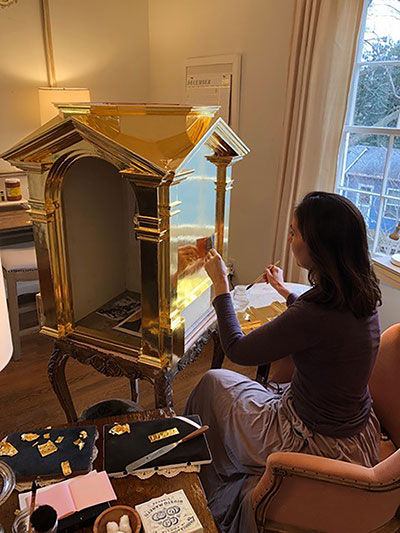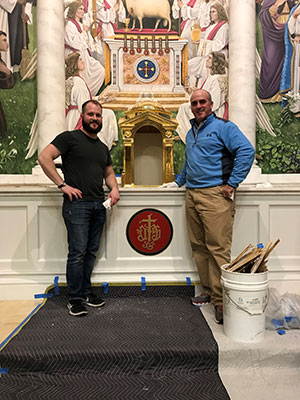CHARLOTTE — U.S. Immigration and Customs Enforcement agents arrested more than 200 people in multiple operations last week across North Carolina, including the father of a St. Joseph College Seminary student.
About 60 of the detainees, including the father of seminarian José Palma, have no criminal records, ICE acknowledged in an announcement Feb. 8.
Palma’s father Francisco Palma was arrested in Asheboro while ICE agents were looking for another person. The 48-year-old father of six came to the U.S. from Mexico 22 years ago to seek a better life for his family – especially medical help for a daughter with speech and hearing problems. He worked on farms and later in construction to provide for his family. And now besides having a son in the college seminary, one of his daughters has entered a religious order in Gastonia.
Francisco Palma was released Feb. 12 and allowed to return home after his family posted a $5,000 bond, but he must attend an immigration hearing and remains at risk for deportation. The family is working with immigration attorneys on his case.
Palma said his family was shocked by the arrest and the subsequent rapid transfer of his father to a federal detention center in Atlanta.
“I understand that my father, to come here, broke a law. I also broke it, although I was too young to know that I was also breaking a law,” Palma acknowledges. “But I feel it is an injustice because my father did not come to harm this country, he came to do good things. He is a good man who has given me a great example, and to imagine him today in prison for seeking a better life breaks my heart.”
Despite living and working in the U.S. for more than two decades, immigration law prevented Palma’s father from obtaining legal status without first having to return to Mexico. His entry without authorization made him ineligible for any regularization benefit.
Palma said he understands the impact and seriousness of the law, but he also expresses hope that the U.S. would be merciful to foreigners as the Bible commands – especially well-meaning foreigners who help support their local communities.
“I understand that the country cannot accept everyone, and the example of some bad guys has damaged the image of an entire community that seeks to do good,” he said. “We cannot demand if we do not contribute.”
If his father is deported, Palma said, his family will be split up as his mother, who is inconsolable, would follow her husband back to Mexico. Palma himself was a DACA beneficiary and now has a religious visa to stay in the country.
In spite of everything, Palma remains firm in his vocation and asks for people to pray for his family at this difficult time.
“As far as I can discern at this moment, God wants me to be in the seminary and I cannot leave my vocation. If God uses this to purify my family, I accept it,” he said. “Although I am angry, sad and upset about many things, I trust that God will solve everything according to His plans. God never gives suffering without getting something good because in the same way, He redeemed us all. And as Christians we are called to be like Jesus.”
— César Hurtado, Hispanic reporter
‘A work of great beauty to house Beauty Himself’
 CHARLOTTE — A new tabernacle graces the sanctuary of St. Ann Church, thanks to parishioners’ donations and the work of several local artists.
CHARLOTTE — A new tabernacle graces the sanctuary of St. Ann Church, thanks to parishioners’ donations and the work of several local artists.
The 100-pound tabernacle, made of gilded poplar and basswood, was designed by architect James McCrery to complement the church’s architecture and its scale within the sanctuary. Local artists Jacob Wolfe and Mary Clark, who have created artwork for several other churches in the Diocese of Charlotte, decorated the tabernacle. Metalsmith Seth Gould of Asheville crafted a custom key and lock, and St. Ann parishioner James McCarthy cut the marble for the tabernacle’s installation.
“Hundreds of parishioners” donated to the tabernacle project, noted Father Timothy Reid, pastor, “because of their love of the liturgy.”
The front bas-relief panel of the tabernacle depicts the Annunciation in a Romanesque style, matching the church’s architectural design.
Wolfe, a master carver and sculptor, estimates that he put more than 300 hours into building and sculpting the tabernacle.
“My goal in this work was to put the focus on Our Lady while having all the supporting elements within the small area,” he said. “It was challenging to pull this off because I had to keep in mind that it would be gilded, which changes surface texture significantly and how things are perceived by the viewer.”
Once Wolfe completed his woodworking, Clark began the painstaking process to gild the tabernacle using 1,500 pounded sheets of 23.75-carat gold. It took her about a year to complete the work of traditional water gilding, which involves carefully applying crushed stone, rabbit and fish skin glue, linen, red clay and gold sheets in layer after layer.
“It was a privilege of a lifetime to work on this tabernacle, not only as an artist but also as a Catholic,” Clark said. “I am so pleased for the parishioners of St. Ann and for the entire Catholic community that Father Reid had such a noble goal as a gilded tabernacle for Our Lord. (It is) a work of great beauty to house Beauty Himself! I am humbled and grateful to have been a part of this historic piece.”
A new tabernacle has been in the plan for St. Ann Parish ever since the new church was dedicated in 2009, Father Reid said. And when the parish unveiled its spectacular apse mural, done in the style of “Adoration of the Lamb” by Jan Van Eyck, the artwork was planned with a new tabernacle in mind.
“We wanted something that kept with the particular beauty of St. Ann Church,” Father Reid said. “When you walk into the church your eye is drawn there. Your eye goes right to it, and that is on purpose. There’s a continuous line of sight up the aisle, to the altar, to the sanctuary lamp, to the tabernacle, to the mural of the Holy Trinity.”
Using local artists such as Wolfe and Clark, as well as the talents of parishioners, is “a form of stewardship,” Father Reid noted. “We save money by keeping it in the diocese. It’s important that we do something locally. It gives the people pride. If we want nice things in the diocese for God, then we have to help people develop their talents to provide them.
“This tabernacle, like our Church itself, is meant to be an expression of the faith of the parish. We want to make sure we give God the very best as a parish.”
— SueAnn Howell, senior reporter


Watch video of Mary Clark working on a tabernacle for St. Joseph College Seminary

